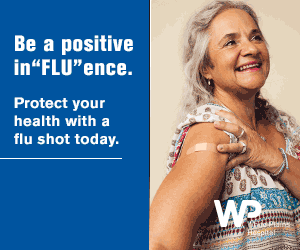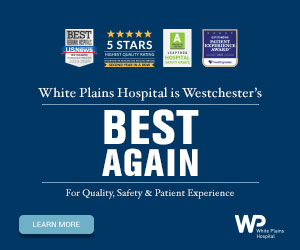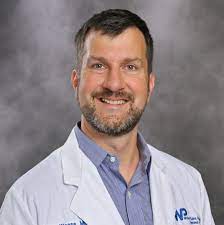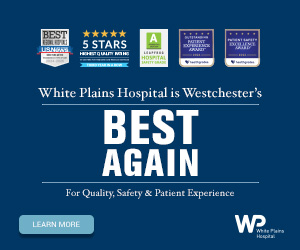Why Get the Flu Vaccine? There Are Thousands of Reasons
- Details
- Written by: Joanne Wallenstein
- Category: Health
 (Submitted by Dr. Gary A. Zeitlin, Infectious Disease at White Plains Hospital)
(Submitted by Dr. Gary A. Zeitlin, Infectious Disease at White Plains Hospital)
You hear it every year at about this time: Don’t forget to get your flu shot. But there is a very good reason for that: simply put, not enough people are getting vaccinated.
Of course, 100% can be difficult to achieve in almost anything, but the numbers are especially concerning when it comes to fighting influenza. According to the latest available CDC data, in the 2022–23 flu season, 57.4% of children 6 months through 17 years were vaccinated, and only about 47% of adults over 18 were vaccinated. This is simply not enough.
Consider that, for the 2024 flu season in the U.S., the CDC estimates:
• 34 million to 75 million flu illnesses
• 15 million to 33 million flu-related medical visits
• 380,000 to 900,000 flu-related hospitalizations
• 17,000 to 100,000 flu-related deaths
According to the American Medical Association, some of the commonly heard reasons for not getting an annual flu shot include “I’m healthy” or “I got it last year.” The counterarguments here should be obvious: you may not stay healthy if you’re exposed to the virus, and since influenza is constantly mutating, last year’s vaccination will not be as effective as this year’s, which has been modified to take into account this year’s variety.
There is also the fact that many of us “got tired” of getting vaccinated after the multiple rounds during the pandemic. The fact remains that a flu vaccination is your best bet against what could range from some annoying sniffles to serious complications.
Incidentally, COVID is still very much around, and new boosters are available. I encourage everyone to get both vaccines, which can be received during the same appointment.
Flu vaccination is recommended for those six months and older every year for optimal protection, especially for groups at higher risk for developing complications, including:
• Adults 65 years and older
• Adults with chronic conditions including asthma, heart disease, stroke, diabetes, and chronic kidney disease
• Pregnant women Whether we ever get within striking distance of 100% compliance on getting the flu vaccine is impossible to foretell. However, the reality remains that receiving the vaccine is of considerable importance. Let’s all be a positive in”flu”ence. Schedule your shot today.
Whether we ever get within striking distance of 100% compliance on getting the flu vaccine is impossible to foretell. However, the reality remains that receiving the vaccine is of considerable importance. Let’s all be a positive in”flu”ence. Schedule your shot today.
Dr. Gary Zeitlin is an attending physician and Director of the Infectious Disease Division at White Plains Hospital. To make an appointment for a flu shot, call 914-849-MyMD.
Health Matters
The original version of this article was published in Health Matters, a White Plains Hospital publication.
Next-Gen Pacemakers Now Available at White Plains Hospital
- Details
- Written by: Joanne Wallenstein
- Category: Health
 Every year, around 250,000 people in the U.S. receive a cardiac pacemaker to help steady their heartbeat, according to research estimates. Now, many will qualify for a new type of pacemaker: an innovative, dual-chamber wireless option. White Plains Hospital is the first hospital in the state north of New York City to offer this technology to its patients.
Every year, around 250,000 people in the U.S. receive a cardiac pacemaker to help steady their heartbeat, according to research estimates. Now, many will qualify for a new type of pacemaker: an innovative, dual-chamber wireless option. White Plains Hospital is the first hospital in the state north of New York City to offer this technology to its patients.
A pacemaker is often recommended for patients whose heart rate is too slow and are having symptoms like fainting or dizziness. Traditionally, the device is implanted close to the shoulder, with wires connecting it to the heart. This new technology—the AVEIR DR dual-chamber leadless pacemaker system—means no wires are necessary at all.
As a result, “patients will now be able to have a pacemaker that they don’t see or feel. It’s working in the background and they don’t have a constant reminder,” says Dr. Marc Waase, Ph.D., a board-certified Cardiac Electrophysiologist and Director of Cardiogenetics at the White Plains Hospital Center for Advanced Medicine & Surgery.
Also key: The new technology can be offered to a greater number of patients, including those on dialysis who were previously not eligible for a pacemaker. “Almost everybody who needs a pacemaker is going to be eligible for the AVEIR DR dual-chamber leadless pacemaker system,” says Dr. Waase.
That’s in part because, as a dual-chamber pacemaker, it helps both the top and the bottom chambers of the heart work together. More than 80 percent of patients require this type of pacing. (Single-chamber wireless pacemakers already exist, but these are only helpful for the small number of people who need pacing in just one chamber, Dr. Waase explains.)
Here’s how the AVEIR DR pacemaker works: Instead of being implanted in the shoulder, the leadless dual-chamber pacemaker is placed directly in the heart. During the minimally invasive procedure, which was first performed at White Plains Hospital in April 2024, a catheter is inserted into the groin. Then, two small devices are implanted directly into the top and bottom chambers of the heart. These two devices communicate with each other to establish steady heartbeat pacing.
Plus, there is no scarring and no shoulder-activity restrictions. “[In the past] we’ve limited patients’ activity with their arms—no lifting, playing tennis, playing golf. Now that restriction will be lifted because they don’t have that device in their shoulder,” says Dr. Waase. The device is estimated to last as long as 20 years, compared to a traditional pacemaker’s 10 to 12 years. Traditional wired pacemakers will still be used in specific cases, such as for people with heart failure. And Dr. Waase doesn’t recommend patients who currently have a pacemaker switch to the new technology unless there’s an issue with their device.
Traditional wired pacemakers will still be used in specific cases, such as for people with heart failure. And Dr. Waase doesn’t recommend patients who currently have a pacemaker switch to the new technology unless there’s an issue with their device.
Overall, as Dr. Waase notes, “This is state-of-the-art technology that gives our patients more options and is an innovative, important step forward in the care we provide here at White Plains Hospital.”
Dr. Marc Waase is a board-certified cardiac electrophysiologist and Director of Cardiogenetics at the White Plains Hospital Center for Advanced Medicine & Surgery. For an appointment, call 914-849-2690.
Health Matters
The original version of this article was published in Health Matters, a White Plains Hospital publication.
Osteoporosis: What to Know
- Details
- Written by: Joanne Wallenstein
- Category: Health
 ( Submitted by Dr. Mythili Murthy, Endocrinology, Diabetes & Metabolism)
( Submitted by Dr. Mythili Murthy, Endocrinology, Diabetes & Metabolism)
As we get older, we lose bone mass—often gradually, and never noticeably. That’s why the condition of brittle bones, known as osteoporosis, is often called the “silent disease.” It progresses without symptoms until a bone easily breaks from a minor fall or even from something as ordinary as bending, lifting, or coughing. But osteoporosis doesn’t have to come as a surprise. Becoming familiar with your risk, warning signs, and preventative care can help you stay strong and prevent potential injuries.
Here, Dr. Mythili Murthy, Endocrinologist at White Plains Hospital Physician Associates, explains who is at risk for osteoporosis, shares strategies for prevention and detection, and notes the perks of personalized care. Here are tips to keep in mind:
1. Start to monitor during menopause. One of estrogen’s roles as a hormone is to regulate and replenish the production of new, healthy bone cells, explains Dr. Murthy. When estrogen levels decrease, usually starting at around age 50, bone density often follows suit. That’s why menopausal women are especially at risk. (For men, 70 is the age linked with a higher chance of osteoporosis.)
2. Cut back on smoking, alcohol, and coffee. “We know that smoking cigarettes and drinking excessive alcoholic or caffeinated beverages can hasten loss of bone density,” Dr. Murthy says. She advises no more than two cups of coffee per day to retain bone strength—or, if needed, to rebuild it.
3. Ask your doctor about scheduling a DEXA scan, an imaging test that assesses the density of your bones by measuring their mineral content. Results can indicate whether your bone density is normal,
slightly thin, or very thin. Slightly thin density is called osteopenia; very thin density indicates osteoporosis. DEXA scans should be repeated every one to two years.
4. Practice weight-bearing and strength-training exercises. Dr. Murthy recommends exercises such as walking, climbing stairs, or lifting weights for 30 minutes a day, three to four times a week. In terms of rebuilding bone strength, these are preferable to cardio exercises, she says.
5. Eat your spinach, drink your smoothie. “Calcium is among the most important minerals for strengthening bones. We recommend 1,200 mg a day, chiefly through the foods you eat,” says Dr. Murthy. You don’t have to pop extra calcium tablets if you’re having a daily cup of milk, a container of yogurt, a serving of leafy green vegetables, a handful of almonds or entrees with tofu or fish.
6. Vitamin D is the other important supplement, working in tandem with calcium to fortify bones. “Because Vitamin D comes from exposure to the sun, most people in our region have low levels so it’s important to take supplements,” Dr. Murthy says. “The standard dose is 2,000 IU, but it varies.” It is important to note that wearing sunscreen does not block Vitamin D. 7. Consider bone-building medications. “There are a range of options, from daily oral medication to monthly injections to yearly IV infusions,” explains Dr. Murthy. “It’s based on the individual and what best suits their needs. Each treatment has different side effects. For example, some oral medications trigger acid reflux, so we switch that patient to a yearly infusion. Other patients come to us with advanced osteoporosis, which might result in a decision to perform monthly injections for bone stability.”
7. Consider bone-building medications. “There are a range of options, from daily oral medication to monthly injections to yearly IV infusions,” explains Dr. Murthy. “It’s based on the individual and what best suits their needs. Each treatment has different side effects. For example, some oral medications trigger acid reflux, so we switch that patient to a yearly infusion. Other patients come to us with advanced osteoporosis, which might result in a decision to perform monthly injections for bone stability.”
Dr. Mythili Murthy is a board-certified internist and endocrinologist at WPHPA of Harrison. For an appointment, call 914-835-0073.
Health Matters
The original version of this article was published in Health Matters, a White Plains Hospital publication.
A Range of Treatments for Prenatal Kidney Issues
- Details
- Written by: Joanne Wallenstein
- Category: Health
 (Submitted by Dr. Amanda C. North, Pediatric Urology at White Plains Hospital)
(Submitted by Dr. Amanda C. North, Pediatric Urology at White Plains Hospital)
Unlike conditions of the heart, liver, and other singular organs, most people can live normal lives with just one kidney. However, a condition called prenatal hydronephrosis – essentially the swelling of a kidney in a fetus or infant – may require medical intervention to make sure the developing child is on the right path to good health.
Prenatal hydronephrosis affects between 0.5 to 1% of all pregnancies. The condition is typically brought on by a buildup of urine in the kidney due to a blockage somewhere in the urinary tract – that is, the ureter, urinary bladder, or urethra. The most common type of blockage is a ureteropelvic junction (UPJ) obstruction, involving a blockage where the kidney joins the ureter, which is the thin tube that carries urine to the bladder.
In prenatal cases, hydronephrosis is usually diagnosed during the second trimester via ultrasound. One clue can be low levels of amniotic fluid in the womb; as a fetus’ urine is part of the amniotic fluid, a significantly low level of the latter may indicate that the fetus is not passing enough urine. A swollen abdomen in the fetus can also raise suspicions. In such cases, parents are referred to a pediatric urologist before the baby is born so that they understand and are prepared moving forward.
Usually a sonogram will be given on the newborn within 48 hours of birth; the delay is due to the fact that the amount of fluid in the kidneys depends upon how well hydrated the newborn is. Although hydronephrosis may correct itself, the pediatric urologist will assign a ranking of 1 to 3 to the infant’s situation, with 1 being a minimal case and 3 being a severe one. Persistent mild and moderate cases can often be treated through watchful waiting with or without preventative antibiotics, followed by ultrasounds to measure improvement.
Surgery may be necessary in severe cases, with the aim of reducing the pressure in the kidney by relieving the obstruction. A pyeloplasty, used to address a UPJ obstruction, involves removing the blocked part of the ureter and reconnecting the healthy portion to the kidney’s drainage system.
¬With the less common ureterovesical junction (UVJ) obstruction – a blockage at the point where the ureter joins the bladder – a ureterostomy may be performed. This involves disconnecting the ureter from the bladder and making a surgical incision called a stoma, which drains into a diaper. The ureter will later be re-inserted into the bladder as the baby grows. In older babies and children, the ureter may be reimplanted into the bladder directly without first requiring a ureterostomy.
Depending on the age and general health of the patient, robotic surgery may be an option. In any case, such operations usually take between 1 ½ and 3 hours and have a 97-98% success rate for patients of all ages.
The prospect of surgery for a baby is an emotional and complicated one for any parent. But there are solutions when it comes to prenatal hydronephrosis. Consult with your pediatrician and a pediatric urologist to get the right answers for you and your child. It is also important to note that hydronephrosis can occur at any age. Severe cases may lead to kidney damage and even kidney failure. Depending on the severity, dialysis or a kidney transplant may be advisable for older patients. The good news is that around 90% of hydronephrosis cases – whether prenatal or postnatal – do not require any intervention; they essentially resolve themselves, or the unaffected kidney does the job of both without any complications.
It is also important to note that hydronephrosis can occur at any age. Severe cases may lead to kidney damage and even kidney failure. Depending on the severity, dialysis or a kidney transplant may be advisable for older patients. The good news is that around 90% of hydronephrosis cases – whether prenatal or postnatal – do not require any intervention; they essentially resolve themselves, or the unaffected kidney does the job of both without any complications.
Dr. Amanda C. North is Chief of Pediatric Urology and an attending physician at the Children’s Hospital at Montefiore (CHAM). To make an appointment, call 914-849-5437.
Health Matters
The original version of this article was published in Health Matters, a White Plains Hospital publication.
How Seriously Should You Take a Smartwatch’s AFib Alert?
- Details
- Written by: Joanne Wallenstein
- Category: Health
 (The following was submitted by Martha G. Ferrara, Nurse Practitioner at White Plains Hospital)
(The following was submitted by Martha G. Ferrara, Nurse Practitioner at White Plains Hospital)
Advancements in technology continue to occur at a rapid pace – so rapid, in fact, that they may cause your heart to beat a little faster. But when it comes to smartwatches, they can convince someone that their altered heartbeat means they have atrial fibrillation (AFib), a serious condition that poses an increased risk of stroke and heart failure.
AFib is a quivering or irregular heartbeat (arrhythmia) that can lead to those and other heart-related complications. Over 12 million people are projected to have AFib by 2030, according to the American Heart Association, which says the condition increases the risk of stroke fivefold.
We all want to be aware of potential risks to our health, but in this case, a little information can perhaps not be enough. Our office is, on many days, overwhelmed with owners of an Apple Phone, Fitbit, Samsung Galaxy, and similar devices that have provided a “you may have AFib” alert – and who are understandably concerned.
Smartwatches use a kind of electrocardiogram (ECG) technology that monitors blood flow and heart rate throughout the day; any irregular rhythms are then “alerted.” One of the problems we are encountering is that the technology may be outpacing the reality.
I am certain that most of us have at some point felt that odd sensation indicating an irregular heartbeat or even the “skipping” of a beat. But is that enough to conclude that you have AFib?
The answer is “no,” according to the U.S. Preventive Services Task Force (USPSTF). That organization issued a report in January 2022 finding that the likes of smartwatches and smartphone apps, automated blood pressure cuffs, and pulse oximeters are no match for an ECG screening of an asymptomatic patient in a healthcare provider’s office when it comes to an accurate AFib screening.
To be clear, the USPSTF is not saying that such devices’ alerts are invalid – just that there is not enough data to conclude that asymptomatic patients should completely trust those devices’ suggestive diagnoses.
Fortunately, technology companies appear to be aware of this ever-more-complex situation. Representatives from many areas and disciplines, such as cardiac device industry, tech companies, entrepreneurs, scientists, and engineers attend the annual HRX meeting – a digital health conference sponsored by the Heart Rhythm Society, the leading scientific organization on cardiac pacing and electrophysiology, now in its third year. They are joined by electrophysiologists and nurse practitioners like me, as well as physicians and many stakeholders in this area, to engage in an open and collaborative discussion about the current situation and the exciting potential for digital health “wearable” tools going forward.
In addition, White Plains Hospital’s Cardiac Electrophysiology program remains at the forefront of the specialty, having been selected to participate in a study sponsored by the National Institutes of Health and Johns Hopkins University. The multi-year, nationwide study known as the REACT-AF trial is a randomized, controlled trial exploring the incorporation of wearable technologies into the management of AFib and usage of anticoagulation (“blood thinners”) therapy.
I believe that such collaborative sharing of knowledge and information is the wave of the future – one that will no longer find patients stranded somewhere in the middle but focus our patients at the center of care.
In the meantime, if you do receive an AFib alert and are concerned about what it could mean, contact your primary care physician to discuss. Feeling heightened anxiety or even panic is never a good thing, especially without understanding your own medical history. Your PCP should be able to set your mind, at least partly, at ease by either ruling out AFib or by recommending you see a specialist. Martha G. Ferrara is the Assistant Director of Electrophysiology Services at White Plains Hospital. For an appointment, call 914-849-2690.
Martha G. Ferrara is the Assistant Director of Electrophysiology Services at White Plains Hospital. For an appointment, call 914-849-2690.
Health Matters
The original version of this article was published in Health Matters, a White Plains Hospital publication.










